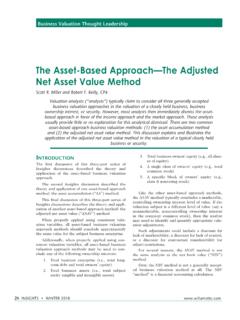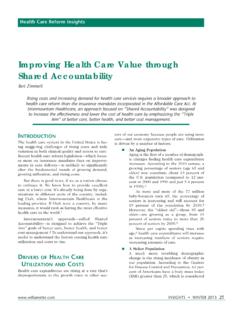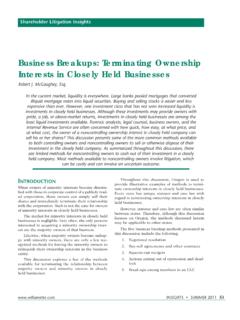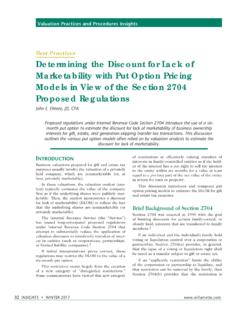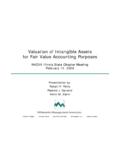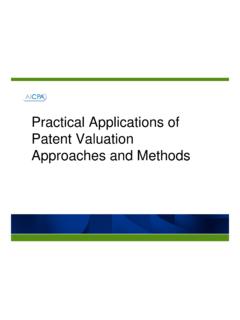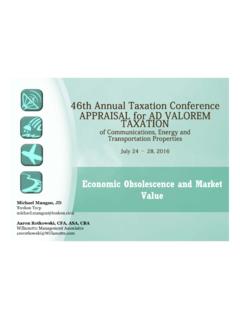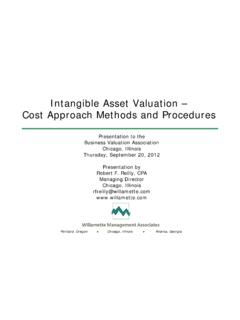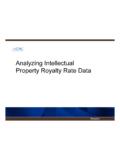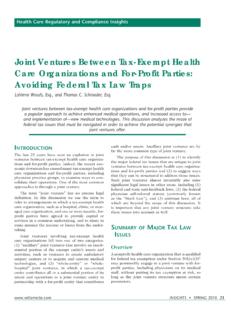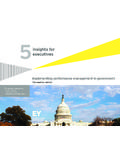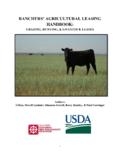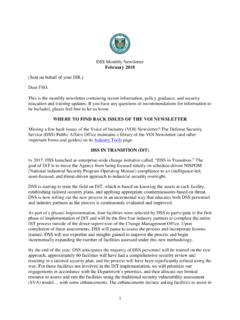Transcription of Issues Related to the Treatment of an NOL Carryforward in ...
1 Business valuation insights Thought Leadership Issues Related to the Treatment of an NOL Carryforward in income approach valuation Methods Aaron M. Rotkowski and Robert F. Reilly, CPA. Property tax assessors often value centrally assessed taxpayers using income approach unit valuation methods. Such income approach valuation methods include the direct capitalization method and the yield capitalization method. For taxpayers that have accumulated a net operating loss (NOL) Carryforward , some property tax assessors (1). estimate taxpayer normalized net operating income (NOI) based on a 0 percent income tax rate but (2) apply an after-tax ( , tax-affected direct capitalization rate in the income approach valuation analysis. This discussion considers if such a 0 percent income tax rate assumption is appropriate in the income approach valuation of a taxpayer unit for property tax valuation purposes.)
2 And, this discussion considers if and how the use of such a 0. percent income tax rate assumption may overstate both the value of the taxpayer unit and the value of the NOL tax attribute component of the taxpayer unit. Introduction estate only. Some jurisdictions tax tangible personal property only. Many jurisdictions tax tangible For ad valorem property tax purposes, the total assets only ( , real estate and tangible personal operating assets of centrally assessed industrial and property) but not intangible assets ( , intangible commercial taxpayers is often valued using unit personal property). valuation methods. The taxpayer unit value conclu- If the centrally assessed taxpayer total value sion from the application of unit valuation methods concluded from a unit valuation method includes represents the sum of all of the taxpayer corpora- any value attributed to assets that are not subject to tion real estate personal property operating assets.
3 Property taxation in the subject jurisdiction, then both tangible and intangible. 1. those nontaxable assets should be separately valued Centrally assessed taxpayers subject to unit and extracted from the total taxpayer unit value. valuation methods often include telecommuni- This discussion considers the valuation and cation companies, railroads, airlines, pipelines, extraction of a taxpayer NOL tax attribute . electric power companies, cable TV companies, and similar income tax attributes in an income water and wastewater companies, and other similar approach valuation analysis performed for prop- utility-type companies. These types of taxpayers erty tax purposes. More specifically, this discus- are often centrally assessed for property tax pur- sion considers the appropriateness of applying a 0. poses. However, similar types of taxpayers may also percent income tax rate assumption in the income be locally assessed using unit valuation approaches projection of any income approach valuation .
4 And methods. These taxpayer companies often own and operate both tangible assets and intangible This discussion focuses on the tax rate assump- assets. tion applied in a direct capitalization method analy- sis that is, where the taxpayer NOI is divided by a Not all taxing jurisdictions tax all categories direct capitalization rate. However, this discussion of taxpayer assets. Some jurisdictions tax real insights SUMMER 2015 53. also applies to the tax rate assumption applied in a Either of these procedures may result in the tax- yield capitalization method analysis that is, where ing authority estimating the taxpayer normalized the taxpayer net cash flow (NCF) is present valued at NOI based on a 0 percent (or a similarly low) tax a yield capitalization rate. This discussion refers to rate. this particular income tax rate valuation variable as In an income approach unit valuation , the tax- the 0 percent tax rate assumption.
5 Payer unit value is estimated based on the expected For purposes of this discussion, the unit valu- future income that is associated with the total tax- ation income approach methods include both (1) payer unit. Since any income approach valuation the direct capitalization method and (2) the yield methodology is forward-looking, the use of the 0. capitalization method. The valuation formula that percent tax rate assumption to estimate normalized is often used in the direct capitalization method is: NOI indicates that the NOL Carryforward (which is (1) expected NOI divided by (2) direct capitalization also forward looking), and not the NOL carryback rate equals (3) the taxpayer total unit value. (which is backward looking), is included in the tax- payer unit value. The valuation formula that is often used in the yield capitalization method is the sum of (1) the Therefore, the current discussion relates to a present value of the taxpayer expected NCF esti- taxpayer's NOL Carryforward and not an NOL car- mated over a discrete projection period plus (2) ryback.
6 This is because taxing jurisdictions that use a residual value (often estimated using the NCF the 0 percent tax rate assumption do not value or divided by direct capitalization rate formula) equals assess property tax on the taxpayer's NOL carry- (3) the taxpayer total unit value. back. NOL carryforwards and NOL carrybacks are dis- The taxpayer NOI in the direct capitalization cussed in the next section. formula represents the amount of income projected for a single future period. This projected taxpayer First, this discussion defines an NOL carryfor- NOI should be normalized or stabilized in order ward and an NOL carryback. Second, this discussion to represent a typical level of expected income on a considers if an NOL Carryforward (or, for that matter, forward-looking any income tax attribute) should be categorized as tangible property (and would, therefore, be subject This tax rate assumption issue is relevant to ad valorem taxation in many taxing jurisdictions).
7 Because some taxing jurisdictions estimate taxpay- Third, this discussion analyzes the appropriateness er NOI assuming a 0 percent tax rate for taxpayers of the 0 percent tax rate assumption in a unit valua- with certain income tax attributes. The taxing juris- tion analysis intended to reach a market value con- dictions that use the 0 percent tax rate assumption clusion. Fourth, this discussion explores the appro- often support this procedure by noting the exis- priateness of applying an after-tax capitalization rate tence of a taxpayer's NOL Carryforward (or similar (whether a direct capitalization rate or a yield capi- federal income tax attribute). Often, the subject talization rate) to a pretax income stream. Fifth, this taxpayer has accumulated the federal income tax discussion describes the federal income tax statutory NOL Carryforward due to negative operating income limitations on the use of an NOL Carryforward and earned during the economic downturn of the last considers the implications of incorporating a tax- several years.
8 Payer's NOL Carryforward in a direct capitalization The taxing jurisdictions that use the 0 percent unit valuation . Finally, this discussion summarizes tax rate assumption often follow one of the following the factors that actually affect the market value of an two procedures to estimate the normalized NOI in NOL Carryforward as an individual taxpayer asset. As the income approach valuation : will be discussed, an NOL is only one component of 1. The taxing authority calculates the taxpayer a taxpayer's deferred federal income tax (DFIT) asset normalized NOI based on some historical or liability account. average NOI such as a three-year average or For illustrative purposes only, this discussion a five-year average; and that historical aver- considers the NOL Carryforward position of a hypo- age NOI includes years where the taxpayer thetical centrally assessed taxpayer ( LossCo ).
9 Used its NOL (or NOL carryback) to elimi- For purposes of an illustrative analysis, LossCo is a nate federal income tax expense. hypothetical taxpayer company with a recent history 2. The taxing authority calculates the taxpayer of operating losses. NOI based on the near-term projected NOI In our illustrative example, LossCo: (such as the next fiscal year projected NOI), 1. reported a $10 million NOL Carryforward as which may include the assumed use of the of December 31, 2014, in its audited finan- taxpayer NOL Carryforward . cial statements;. 54 insights SUMMER 2015 2. reported $4 million as the NOL component a tax attribute that is included as one component of its deferred federal income tax asset in the overall calculation of the deferred income tax account; asset (or liability) account on a taxpayer's GAAP- 3. reported a net deferred income tax asset based balance sheet.
10 (liability) account as a liability (or credit In addition to an NOL Carryforward , differences balance) of $1 million; and between the taxpayer company's pretax income 4. projected that its taxable income will equal (reported in accordance with GAAP) and the tax- $1 million in 2015. payer company's taxable income (reported in accor- dance with the Internal Revenue Code) also give rise to a deferred income tax asset or a deferred income Even though the NOL Carryforward tax attribute tax liability. The deferred income tax account is component of the deferred income tax asset was often recorded on the taxpayer's balance sheet as positive, the LossCo reported net DFIT asset (liabil- DFIT. ity) account was negative ( , a credit balance) as of According to the Financial Accounting Standards December 31, 2014. Board (FASB) Accounting Standards Codification (ASC) topic 740-10-10-3, Conceptually, a deferred tax liability or asset represents the increase or Definition of an NOL decrease in taxes payable or refundable in future An NOL: years as a result of temporary differences and car- occurs for tax purposes in a year when tax- ryforwards at the end of the current year.
